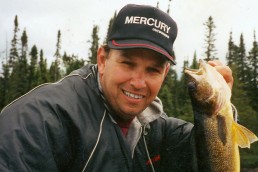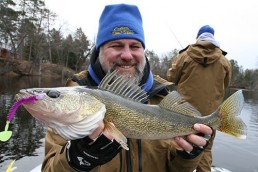SHARE THIS POST
It happens most springs here in our Midwestern rivers as high water from runoff due to rains and snowmelt raises water levels. When these conditions do occur, many who enjoy fishing the Mississippi, Wisconsin and Illinois rivers just to name a few, tend to stay home and wait until the waters recede before going out.Well, those anglers are missing out on some early-spring fishing in spite of the higher water levels. With a little planning on your part, you can still go out and enjoy a great day on the water and catch a mess of fish for the frying pan.
When looking for walleyes holding in these flooded timber areas to concentrate our efforts on, it sometimes can get mind-boggling exactly where to start. With so much visible flooded area, it can be confusing. First of all, you have to remember that the fish have not left the river but have simply moved to more suitable and comfortable locations where they don’t have to fight stronger currents that come with the higher waters. But they will also seek locations where baitfish are so they can grab an easy meal when hungry. This is where the beauty of fishing flooded timber and shorelines with willows comes into play.
These areas usually hold good concentrations of fish for the angler willing to have patience. Now, yes, you will occasionally get hung up to a snag in these locations, but this is to be expected. If you’re not presenting your offering where the fish are, you might as well be at home. With a bit of effort on your part you will more often than not score on some really nice walleyes.
I recommend picking out a nice stretch of flooded brush or timber about 100 yards long and use that as your starting point. If you fish it correctly and slowly, as is required, working that 100-yard stretch will be successful, but take time. To be most effective, you’ll want to work every little nook and cranny within the timber and brush for best results. This is where your patience comes in. Remember, slow and methodical presentations will work best.
For your presentation, we are going to take a card out of the bass angler’s playbook for this. Without a doubt, you have most likely heard the terms pitching and flipping. These are two methods of presenting a bait to the fish by the angler, and both can be quite simple and very effective, when conditions warrant.
Are you enjoying this post?
You can be among the first to get the latest info on where to go, what to use and how to use it!
The first choice that’s proven to be effective over years of river angling is the simple hair jig. I tie my own, but you can buy some. As far as size, I will usually start out with either a 1/8- or 1/16-ounce hair jig, depending on wind conditions. The reason wind is key is that too light of a jig in windier conditions will make accuracy difficult when pitching or flipping your jig to a particular target. You will have to make that determination as to weight depending on your conditions. Remember though, lighter is better if you can control it. Next, you will want to tip that hair jig with a lively minnow in the 2-inch range. Hook the minnow from under the jaw and up out its nostrils to help keep it lively. Now, depending on the distance you are from the flooded timber, either lightly pitch it out or flip it toward your target. When the jig hits the water start your steady retrieve. For best results, experiment with speed until you find what the fish prefer.
The second presentation that has worked well with flooded timber is the same hair jig but tipped with a 3-inch piece of plastic worm. This has also proven to be great for spring walleyes. Pitch or flip it the same way as the minnow rig, and once again, experiment with the lure speed.
One last important fact to mention is that when you’re in high-water areas in spring, don’t worry about always having your presentation close to the bottom. The reason is that within the flooded timbers and willows the walleyes now will have a tendency to suspend as well as cruise at different depths looking for an easy meal to swim by.
Don’t let the high waters of springtime keep you off your favorite river. By changing your tactics and fishing the flooded areas I have discussed, you can enjoy some great walleye fishing. In fact, you might just tie into the biggest walleye of your life. Remember, flooded timber equals big walleyes in May.
MWO
SHARE THIS POST
Did you enjoy this post?
You can be among the first to get the latest info on where to go, what to use and how to use it!
Mike Cyze
Mike Cyze has been called one of the most knowledgeable multispecies river anglers in the country. His ability to catch fish under the challenging conditions encountered in the river environment, combined with his overall fishing knowledge, has earned him recognition as a true Mississippi River Expert. Contact him at: lastcast13@yahoo.com.



